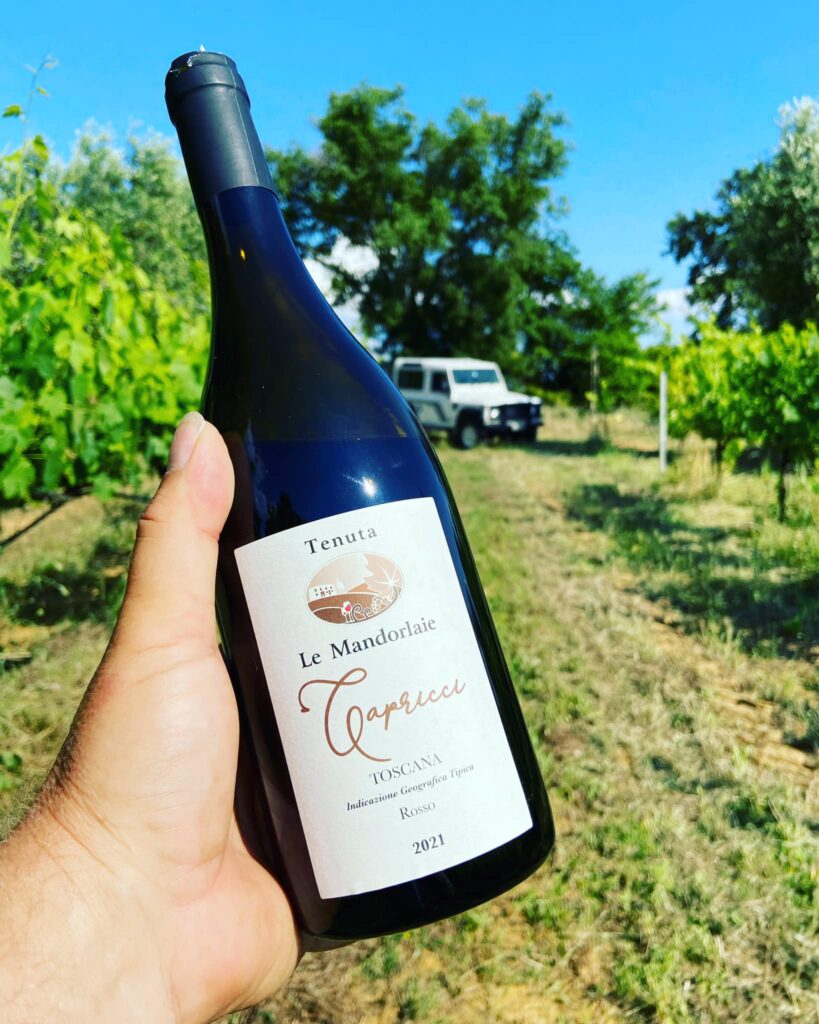
What Does “Capricci” Mean?

All about Capricci
The word “Capricci” is a captivating term that evokes themes of whimsy, spontaneity, and creative freedom. From its origins in the Italian language to its widespread use in art, music, literature, and even wine, the word reflects the dynamic and unpredictable nature of human expression.
In this article, we’ll delve into the meaning of “Capricci,” tracing its etymology and exploring its significance in visual arts, music, and literature, as well as in everyday language. We’ll also discuss “Capricci” as a metaphor for the art of winemaking, particularly focusing on Tenuta Le Mandorlaie’s oak-aged Sangiovese, a wine that beautifully embodies the playful yet complex essence of the term.
The Etymology and Origin of “Capricci”
The word “Capriccio” (singular of “Capricci”) originates from the Italian language and is derived from the Latin term capra, meaning “goat.” This connection to the goat reflects the lively and unpredictable movements of the animal, symbolizing sudden shifts in mood, behavior, or thought in humans. In Renaissance Italy, “Capriccio” came to signify impulsive decisions, driven by whim rather than logic or reason.
Throughout the centuries, the word evolved to encapsulate more than just behavioral changes. It became a term used to describe artistic works characterized by imagination, improvisation, and deviation from traditional norms. In this way, “Capricci” has come to represent an unrestrained, imaginative approach to creativity, where the artist or performer gives free rein to their impulses.
“Capricci” in Visual Arts
In the visual arts, “Capricci” are often used to describe paintings, drawings, or etchings that blend reality and fantasy. These works typically depict imaginary landscapes or architectural scenes, combining real-world elements with fanciful creations. By breaking free from strict realism, artists invite viewers to explore dreamlike worlds where the boundaries between the real and the surreal blur.
One of the most famous artists to use “Capricci” in his work was Giovanni Battista Piranesi, an Italian engraver and architect known for his imaginative etchings of monumental, fictional structures. His series Carceri d’Invenzione (“Imaginary Prisons”) presents vast, labyrinthine spaces filled with arches, staircases, and towering walls—none of which exist in reality. These fantastical images embody the whimsical nature of “Capricci,” illustrating the power of the imagination to create new worlds.
In addition to Piranesi, artists like Canaletto, known for his Venetian landscapes, also incorporated “Capricci” into their works, creating architectural fantasies that combined both real and fictional elements. This genre allowed artists to push beyond the constraints of reality and give expression to their inner visions, offering a sense of wonder and playfulness.
The Surreal and the Unexpected
In visual arts, “Capricci” provide both artists and viewers with an opportunity to explore the unexpected. The fantastical elements of these works challenge our perceptions of reality, encouraging us to look beyond the ordinary and into the realm of imagination. In this way, “Capricci” reflect not just artistic spontaneity but also the human desire to explore the unknown.
“Capricci” in Music
The term “Capriccio” in music refers to a composition that follows no strict form or structure, allowing for greater artistic freedom. These pieces are often characterized by fast tempos, sudden shifts in mood, and playful rhythms, reflecting the capricious and whimsical nature of the word itself.
Niccolò Paganini’s 24 Caprices for Solo Violin are perhaps the most famous example of “Capricci” in music. These technically demanding works require a high level of virtuosity from the performer and incorporate rapid changes in tempo, intricate fingerwork, and dramatic shifts in dynamics. The unpredictable nature of these pieces captures the spirit of “Capriccio,” inviting both the performer and the listener on a journey filled with surprises.
Another notable example is Pyotr Ilyich Tchaikovsky’s Capriccio Italien, an orchestral work inspired by Italian folk music. Tchaikovsky’s composition blends festive melodies with moments of romantic reflection, reflecting the contrasting emotions often associated with “Capricci.” The piece demonstrates the composer’s ability to capture the joyful and whimsical elements of Italian life, using music as a means of conveying the unpredictable beauty of human emotion.
Musical Expression and Emotional Depth
In music, “Capricci” provide a space for emotional exploration, allowing composers to move beyond rigid formal structures and instead create works that capture the complexity of human experience. The unpredictable shifts in mood, tempo, and dynamics mirror the emotional highs and lows that we all experience, making “Capricci” a fitting expression of the richness of life.
“Capricci” in Literature
Although less commonly used in literature, the concept of “Capricci” can apply to storytelling techniques that emphasize spontaneity, imagination, and unconventional narrative structures. Works of magical realism, for instance, often blur the line between reality and fantasy, much like the visual and musical “Capricci.”
In the stories of authors like Gabriel García Márquez and Jorge Luis Borges, ordinary events are imbued with magical or surreal elements. Borges, in particular, is known for creating narratives that defy logic, such as labyrinths that stretch into infinity or characters who experience time in non-linear ways. These stories invite readers to embrace the unexpected and allow the imagination to take flight, much like the artistic “Capricci” of earlier centuries.
The Role of Imagination
“Capricci” in literature challenge readers to move beyond conventional storytelling and embrace the full potential of the imagination. These works often provide a sense of wonder, mystery, and playfulness, as they deviate from established norms to explore the more whimsical aspects of life and the human mind.
“Capricci” in Everyday Life and Language
In everyday conversation, particularly in Italian, the word “capriccio” often refers to a sudden and irrational whim or desire. It is frequently used to describe children’s behavior, such as when they demand something for no apparent reason, driven by fleeting emotions rather than thought-out decisions. In this context, the term conveys the idea of impulsiveness and unpredictability, which are core to its broader meaning.
The word has also made its way into the culinary world. For example, “Insalata Capricciosa” (Capricious Salad) is a dish that combines a variety of ingredients, such as vegetables, ham, and cheese, with a creamy dressing. The name itself reflects the whimsical and unpredictable nature of the salad, as the ingredients seem to be thrown together in a playful, impromptu manner.
“Capricci” in Winemaking: Tenuta Le Mandorlaie’s Oak-Aged Sangiovese
The concept of “Capricci” extends beyond the arts and everyday life, even finding resonance in the world of winemaking. Tenuta Le Mandorlaie, a renowned winery based in the Maremma region of Tuscany, has crafted a wine that embodies the spirit of “Capricci”: their oak-aged Sangiovese, aptly named Capricci.
This wine is a reflection of the whimsical nature of winemaking—where both tradition and innovation intertwine. The name Capricci suggests a sense of playfulness and spontaneity, qualities that are integral to the creation of this complex and expressive wine.
The Art of Crafting “Capricci” Wine
Tenuta Le Mandorlaie’s Capricci is an oak-aged Sangiovese that captures the essence of the region’s terroir while incorporating a layer of unpredictability. Like its namesake, this wine combines a mix of traditions with a creative approach, offering a rich, balanced flavor profile with unexpected notes that delight the palate.
The process of aging the Sangiovese in oak barrels adds depth and complexity to the wine, giving it a bold yet refined character. The oak influences introduce subtle hints of vanilla, spice, and toasted wood, all of which complement the natural fruity and earthy qualities of the Sangiovese grape. These layers of flavor unfold gradually, much like a piece of “Capricci” music, where each movement surprises the listener.
Winemakers at Tenuta Le Mandorlaie embrace the “Capricci” ethos by allowing nature to guide the process, rather than strictly adhering to formulas or rules. The soil, climate, and grapevines themselves contribute their own unpredictable qualities to the final product, creating a wine that, like a work of art, invites the taster to explore its many nuances.
“Capricci” in a Glass, Tasting Notes
When you taste Capricci, you are invited into an experience that reflects the playful and complex nature of the word. The wine opens with aromas of red cherries, plums, and dried herbs, which evolve into richer notes of dark chocolate, leather, and spices as it breathes. On the palate, the wine is full-bodied and well-structured, with smooth tannins and a lingering finish.
Each sip reveals new flavors, much like the unfolding layers of a musical caprice or the intricate details of a capricious painting. The wine’s ability to surprise and delight makes it a true embodiment of the “Capricci” spirit—bold, imaginative, and full of life.
The Enduring Appeal of “Capricci”
Whether encountered in art, music, literature, or wine, “Capricci” celebrates the beauty of spontaneity, creativity, and imagination. In a world that often values structure and order, “Capricci” reminds us of the joy that comes from embracing the unexpected and allowing our minds to wander freely.
By celebrating whimsy and unpredictability, “Capricci” invites us to explore the depths of human emotion and creativity. Whether through a whimsical painting, a virtuosic musical performance, or a bold glass of wine, “Capricci” continues to inspire and delight, offering a glimpse into the boundless possibilities of life.


